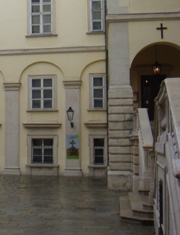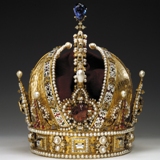The Imperial Treasury Museum (Wiener Schatzkammer)
Since the High Middle Ages outstanding items of special material, religious, artistic or ideal value have been kept in specially secure rooms, so called Treasuries ("Schatzkammern"). The House of Habsburg followed this tradition and set up a treasury in the 14th century, which since the 15th century has been located in the Schweizerhof courtyard of the Hofburg palace, next to the Hofburg Chapel.

History of the Imperial Treasury
Among the most ancient items from the Middle Ages there are the "Holy Grail" and a giant narwhal tooth acquired in Poland in 1540, which was then thought to be the horn of a unicorn. In 1612 the collection was enlarged by important parts of Emperor Rudolf's treasury room in Prague. Emperor Rudolf II was famous for his outstanding sense for the arts and well known as mecenas throughout Europe.
Another magnificent item in the Treasury Museum may be attributed to Emperor Rudolf II, the Crown of Rudolf II, which after the proclamation of the Austrian Empire in 1804 gained in importance as it was from then onwards commonly referred to as the Crown of the Austrian Empire.
In 1782 Emperor Josef II ordered to divide the Treasury into a secular section administered by the Hofburg parish priest and a secular section subject to the responsibility of the Chamberlain (Oberkämmerer). The secular section was considerably enlarged in the aftermath of the French Revolution, when in 1794 the treasury of the Order of the Golden Fleece was transferred from Brussels and in 1800 the Imperial Regalia from Nuremberg to Vienna.
After Napoleon's downfall and the return of his wife Arch Duchess Marie Louise from Austria, the treasury received items from the personal property of the Empress of the French including the notorious Cradle of the Duke of Reichstadt, who was also known from his birth as the "King of Rome". The "Mexican Adventure" of Arch Duke Maximilian from Austria, Emperor from Mexico, brought more magnificent items to Vienna.
The foundation of the Kunsthistorisches Museum Vienna (sometimes referred to as "Museum of Fine Arts" or "Museum of Art History") in 1891 led to the organisatorial integration of the Treasury into the collections of the Kunsthistorisches Museum, while its location in the Schweizerhof (Swiss courtyard) was preserved. Since 1918, there is a division into a secular and an ecclesiastical section, each of them with its own collection.
The Habsburg saved their private jewels from expropriation and took them into their exile on their - today much disputed - expulsion from Austria. Thus the Habsburg private treasures are no longer on display at the Imperial Treasury Museum. However in 1921, the historic collection of the Treasury Museum was considerably enlarged by the acquisition of the treasury of the Capuchin monastery.
From 1938 to 1954, the Vienna Treasury Museum had to close down. After the Austrian Anschluss to the Third Reich, the Imperial Regalia of the Holy Roman Empire were taken to Nuremberg, from where they were only returned by US forces to Vienna as late as in 1946.
Since 1954 the Vienna Treasury has been a museum open to the general public. In 1987 it was enlarged by newly adapted rooms in the South Eastern parts of the Schweizerhof. The Treasury escaped from the fire of the Redoute Ballrooms (Redoutensaele) in the Vienna Hofburg Palace in 1992 almost undamaged, except from some damage in its Security Headquarters due to fire fighting water.
Information about the Vienna Treasury Museum (Wiener Schatzkammer)
This webpage, offered by City Tours Vienna, gives you all important information concerning a visit of the Vienna Treasury Museum (Wiener Schatzkammer). You will find for instance the Opening hours and Ticket prices of the Vienna Treasury Museum (Wiener Schatzkammer), detailled information about the various Guided tours and other affiliated guided tours in Vienna as well as all important information about how to get to the Vienna Treasury Museum.
If you have any additional questions about the Vienna Treasury Museum, you can contact our team via telephone at +43 1 966 02 61 or through e-mail to .
